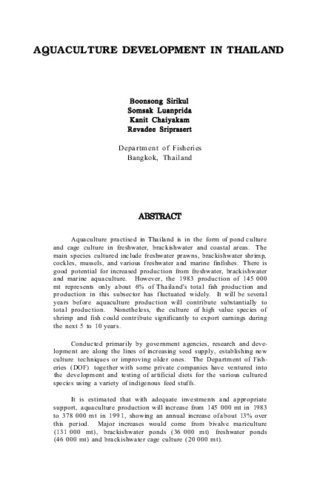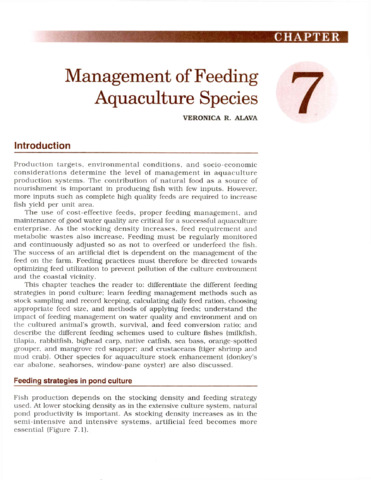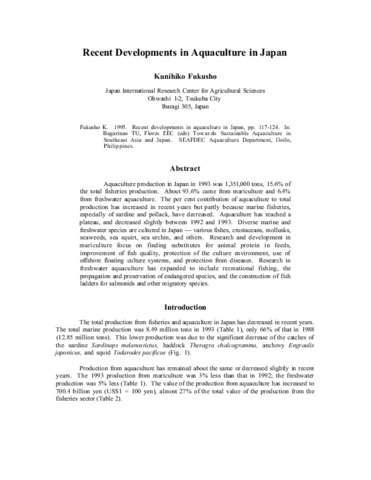Aquaculture development in Thailand
Share
Abstract
Aquaculture practised in Thailand is in the form of pond culture and cage culture in freshwater, brackishwater and coastal areas. The main species cultured include freshwater prawns, brackishwater shrimp, cockles, mussels, and various freshwater and marine finfishes. There is good potential for increased production from freshwater, brackishwater and marine aquaculture. However, the 1983 production of 145 000 mt represents only about 6% of Thailand's total fish production and production in this subsector has fluctuated widely. It will be several years before aquaculture production will contribute substantially to total production. Nonetheless, the culture of high value species of shrimp and fish could contribute significantly to export earnings during the next 5 to 10 years.
Conducted primarily by government agencies, research and development are along the lines of increasing seed supply, establishing new culture techniques or improving older ones. The Department of Fisheries (DOF) together with some private companies have ventured into the development and testing of artificial diets for the various cultured species using a variety of indigenous feed stuffs.
It is estimated that with adequate investments and appropriate support, aquaculture production will increase from 145 000 mt in 1983 to 378 000 mt in 1991, showing an annual increase of about 13% over this period. Major increases would come from bivalve mariculture (131 000 mt), brackishwater ponds (36 000 mt) freshwater ponds (46 000 mt) and brackishwater cage culture (20 000 mt).
Suggested Citation
Sirikul, B., Luanprida, S., Chaiyakam, K., Sriprasert, R. (1988). Aquaculture development in Thailand. In J. V. Juario & L. V. Benitez (Eds.), Perspectives in Aquaculture Development in Southeast Asia and Japan: Contributions of the SEAFDEC Aquaculture Department. Proceedings of the Seminar on Aquaculture Development in Southeast Asia, 8-12 September 1987, Iloilo City, Philippines. (pp. 129-148). Tigbauan, Iloilo, Philippines: Aquaculture Department, Southeast Asian Fisheries Development Center.
Subject
seed (aquaculture)  ; shrimp culture
; shrimp culture  ; feeds
; feeds  ; pond culture
; pond culture  ; mollusc culture
; mollusc culture  ; mussel culture
; mussel culture  ; seed production
; seed production  ; prawn culture
; prawn culture  ; oyster culture
; oyster culture  ; freshwater fishes
; freshwater fishes  ; aquaculture
; aquaculture  ; artificial feeding
; artificial feeding  ; brackishwater aquaculture
; brackishwater aquaculture  ; aquaculture systems
; aquaculture systems  ; clam culture
; clam culture  ; feed composition
; feed composition  ; marine fish
; marine fish  ; aquaculture development
; aquaculture development  ; cage culture
; cage culture  ; seaweed culture
; seaweed culture  ; mariculture; freshwater aquaculture
; mariculture; freshwater aquaculture  ; fish culture
; fish culture  ; Anadara nodifera
; Anadara nodifera  ; Macrobrachium
; Macrobrachium  ; Porphyra
; Porphyra  ; Penaeus
; Penaeus  ; Gracilaria
; Gracilaria  ; Thailand
; Thailand 
 ; shrimp culture
; shrimp culture  ; feeds
; feeds  ; pond culture
; pond culture  ; mollusc culture
; mollusc culture  ; mussel culture
; mussel culture  ; seed production
; seed production  ; prawn culture
; prawn culture  ; oyster culture
; oyster culture  ; freshwater fishes
; freshwater fishes  ; aquaculture
; aquaculture  ; artificial feeding
; artificial feeding  ; brackishwater aquaculture
; brackishwater aquaculture  ; aquaculture systems
; aquaculture systems  ; clam culture
; clam culture  ; feed composition
; feed composition  ; marine fish
; marine fish  ; aquaculture development
; aquaculture development  ; cage culture
; cage culture  ; seaweed culture
; seaweed culture  ; mariculture; freshwater aquaculture
; mariculture; freshwater aquaculture  ; fish culture
; fish culture  ; Anadara nodifera
; Anadara nodifera  ; Macrobrachium
; Macrobrachium  ; Porphyra
; Porphyra  ; Penaeus
; Penaeus  ; Gracilaria
; Gracilaria  ; Thailand
; Thailand 
Taxonomic term
Collections
- ADSEA '87 [20]
Related items
Showing items related by title, author, creator and subject.
-
Aquaculture development in Malaysia
Liong, Pit Chong.; Hanafi, Hambal Bin.; Merican, Zuridah Osman.; Nagaraj, Gopinath. (Aquaculture Department, Southeast Asian Fisheries Development Center, 1988)Malaysia is a fish-consuming country with fish representing 60% of a total animal protein intake. At an annual per capita consumption of 32 kg some 560 000 mt of fish is required for the projected of 17.5 million people ... -
Management of feeding aquaculture species
Alava, Veronica R. (Aquaculture Department, Southeast Asian Fisheries Development Center, 2002)This chapter teaches the reader to: differentiate the different feeding strategies in pond culture; learn feeding management methods such as stock sampling and record keeping, calculating daily feed ration, choosing ... -
Recent developments in aquaculture in Japan
Fukusho, K. (Aquaculture Department, Southeast Asian Fisheries Development Center, 1995)Aquaculture production in Japan in 1993 was 1,351,000 tons, 15.6% of the total fisheries production. About 93.6% came from mariculture and 6.4% from freshwater aquaculture. The per cent contribution of aquaculture to total ...





